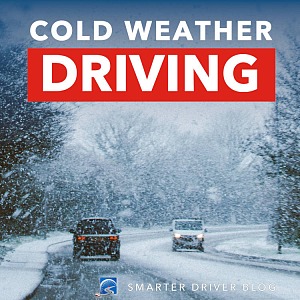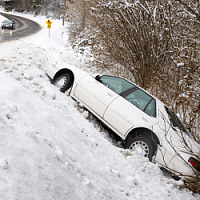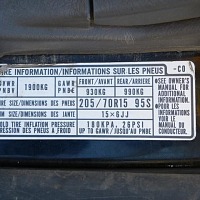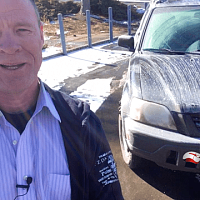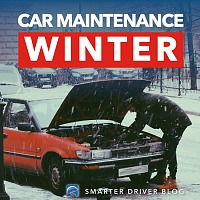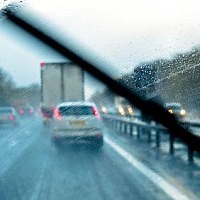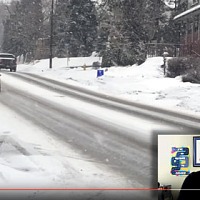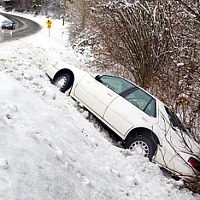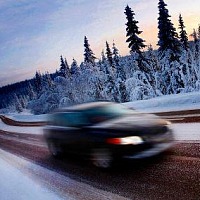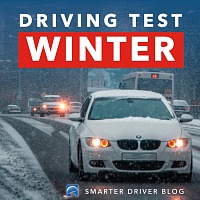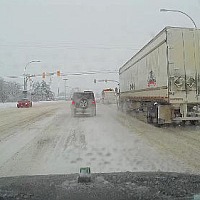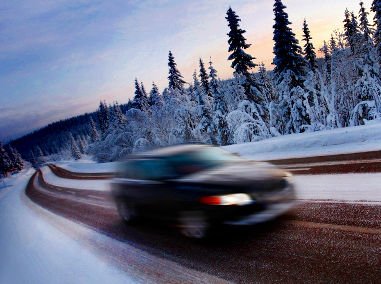11 winter driving tips that will keep you out of the ditch.
https://www.youtube.com/embed/RR6Z_tQ84-0
11 Winter Driving Tips | Winter Driving Smart
Closed Caption
Introduction
Hi there smart drivers, Rick with Smart Drive Test talking to you today about ttt... many tips do we want 10? [CHILDREN TALKING OFF-CAMERA - YAA] Or do we want 11? [CHILDREN - ELEVEN] OK Hi there smart drivers, Rick with Smart Drive Test.
Today we're talking to you about 11 tips for safe winter driving when the temperature is near freezing outside.
And today we have 11 tips for you to be safe in winter driving and to understand the dangers that go along with winter driving when the temperature is near zero (0°C or 32°F).
It is much more treacherous to drive when the temperature is near zero then when it is sub-zero temperatures, therefore it is much more dangerous to drive in Victoria, BC when they get there one snowfall a year, than it is on the prairies when the temperature is minus ten (14°F) or minus 20°C (-4°F).
The reason for that is because there's a layer of water on top of the ice when the temperature is around zero (32°F), which lubricates the ice and makes it much more slippery.
One of the ways you can think about that is an ice-hockey rink after the Zamboni goes out and floods the ice.
It's much more slippery immediately after the Zamboni floods the ice then it is after it has a period of time to actually freeze.
So today we've got 11 tips for you to stay safe, stay out of the ditch, and in the event--the unfortunate event--that you do in fact end up in the ditch, we got tips for that too.
Stick around, we'll be right back with that information.
[OPENING CREDITS & MUSIC]
Hi there smart drivers, welcome back.
Today we have 11 tips for winter driving when the temperature is around the freezing mark.
Because that is much more treacherous to drive then it is in sub-zero temperatures.
Tip #1 - Vehicle Thermometer
Tip number one: equip your vehicle with an outside thermometer.
If you are not driving a vehicle that already has an outside thermometer, go to the hardware store, the auto parts store, and pick one up.
They're very inexpensive and you can put them in your vehicle and these will help you to navigate the dangers of winter driving, and will tell you if there is ice and that all dreaded [ohhhh] black ice.
Watch the video up here - I'll put a card up here for you on black ice.
And just because it's near freezing, doesn't mean you don't know where the ice is.
So you can find the ice, equip your car with an outside thermometer.
Tip #2 - Parts of the Road That Freeze First
Tip number two - and if I wasn't wearing gloves you can see that i was holding up two fingers.
Tip number two is know which parts of the road freeze first.
Bridges and overpasses are going to freeze first because they freeze from both the top and from the bottom.
Areas of the road that lie in shadow; along wooded areas or cliffs.
Those are going to freeze and as well low-lying areas are going to freeze first because cold air is heavier than hot air and it's going to sit down in the valley or down in the bottom of the hill there and it is going to freeze in low-lying areas.
The other place that a lot of people don't know that's going to freeze first is roadways that run near bodies of water.
The air comes over the water, picks up the water and drops it on the road and it's going to freeze there.
So that's another place on the roadway that's going to freeze.
So know the areas of the road that are going to freeze first.
Tip #3 - Clear off all the Snow & Ice From the Vehicle
Tip number three: clear the windows and lights on your vehicle completely before leaving.
Yes we've all seen the vehicles rolling down the road with a foot of snow on the roof.
Make sure you clear all of the snow, so you can be seen and other people can see you when you turn on your lights.
And communicate to them that you in fact are turning and have your lights on and they can see you approaching and those types of things.
That's the reason we have daylight running lights in Canada, because it has been shown that this communicates to other traffic that you're there.
So clean off the car, clean off the lights, clean it off entirely before you set out.
Tip #4 - Top Up Windshield Washer Fluid
Tip number four - tip number four - tip number four - make sure the windshield washer fluid is topped up.
We've all been out on the roadway and get behind other vehicles and the spray coming off the other vehicles and there isn't enough water to just quite make the windshield clean.
And on that note as well, not only top up the windshield washer fluid, but make sure your wiper blades are in good order before you set into winter.
That will just make life so much easier - for fifty dollars you can put new windshield wipers on your car and be safe.
Because let me tell you, if a windshield wiper goes when you're out on the roadway and you stop at a fuel station or you stop somewhere along the roadway to pick up a windshield wiper, they're going to charge you a lot more because this is how gas stations make their money.
So new windshield wipers--good windshield wipers in good condition.
Top up the windshield washer fluid.
Tip #5 - Deft Touch On the Primary Controls
Tip number five: a deft touch on the primary controls: the throttle, the brake, and the steering wheel.
And when I say deft touch - little, gentle movements on these primary controls.
Because any overuse of the primary controls is going to cause you to lose control of the vehicle.
Remember a locked or spinning wheel always leads.
In other words, if the wheels are spinning or locked up, its going to go sideways on you.
So give yourself lots of time - deft control of the primary controls.
Tip #6 - Use the Primary Controls Separately
Tip number six: use the primary controls separately when it's slippery outside.
You can't brake and steer at the same time you.
Let me tell you from personal experience it doesn't work.
When I first got my license--I got my brand-new pickup truck--it wasn't a brand-new pickup truck--it was a used pickup truck ,but it was brand new to me.
I came down the road and hit the brakes, and tried to turn the steering wheel at the same time, and I went right paaaaassssst the roadway where I wanted to turn.
So the primary controls in the wintertime have to be used separately and know as well - all modern vehicles are equipped with ABS brakes (Anti-lock braking systems), that if you come up and it is slippery, the ABS is going to activate, and it is going to take you much, much longer to get that vehicle stopped.
So make sure that you brake early and then creep up to where you want to actually stop.
That's how we do it in the wintertime.
The other thing that you can do to assist braking in the wintertime on slippery condition is to put the vehicle in to neutral.
And most automatic transmissions-- just about ninety percent of them--you can just push the gear selector forward and it will drop into neutral, it won't go into reverse.
So that's another technique that you can use in the wintertime to assist braking.
Use the primary controls separately - so give yourself ample time to get the vehicle stopped before you have to turn.
So do those two things separately.
Tip #7 - Allow Yourself Extra Time
Tip number 7: allow yourself extra time.
Yes we know it's wintertime, yes it's cold, yes you're in bed, and it is so toasty warm and you don't want to get out of bed.
Yet, you're going to need extra time!
You're gonna need extra time to shovel the driveway, to clean off the car completely, and you need extra time to drive there because it's going to take you longer because you need extra time to brake, you need to slow down and not drive as fast.
So I know it's hard--it's a challenge, but allow yourself extra time.
Tip #8 - Avoid Distractions
Tip number 8: avoid distractions in the car in the wintertime when the temperature is around zero (36°F) and it is slippery.
Turn off the radio, don't be drinking, don't be eating.
Focus on driving - two hands on the steering wheel - looking way ahead, concentrating on traffic and trying to interpret traffic patterns.
And again going back to using the primary controls and braking early.
So minimize distractions in the car--in the vehicle that you're driving--so that you're not distracted from the task of driving in the wintertime.
Because the challenges of winter driving--especially when the temperature is around zero degrees Celcius (36°F)--will demand all of your focus, all of your care, and all of your abilities.
So minimize distractions.
Tip #9 - Increase Your Following Distance
Tip number nine: Increase your following distance.
So under ideal conditions, the following distances is 2 -3 seconds.
In the wintertime you might even want to increase that out to 5 seconds, if you're driving a car or light truck - any passenger vehicle.
That way you've got more time to react, more time for deft touch on the controls and you don't need a abrupt evasive maneuvers that will potentially put you in the ditch.
So increase your following distance, give yourself more room, give yourself more time.
And to figure out how far to follow behind other vehicles, according to time, I'll put a card up here for you for following distance.
You can have a look at that and figure out how to follow behind other vehicles, so that you won't find yourself in an emergency situation.
Tip #10 - Be Extra Careful At Intersections
Tip number ten: intersections!
Be aware at intersections because you need to start braking early and then creep up to where you want to stop.
At busy intersections where there's lots of traffic - when the temperature is around zero and there's a layer of water and ice and snow on the roadway - what's going to happen as the cars are coming up and stopping, they're braking, their sliding, & they're creating heat, and they're melting the ice.
And again it goes back to the Zamboni on the ice hockey rink.
They're going to create a layer of water on top of the ice and the intersection is going to be more slippery.
So busy intersections - know there's going to be ice at or near the intersection.
So slow down before you get there and then creep up to the intersection.
On back roads and residential areas, many of these cities don't get out to plow these streets for one, two, three days after you get snow and whatnot.
So know that on residential streets and suburban areas and those types of things, it's just not going to be plowed.
So you're going to have to use more caution and you might even have to use a little power to get out of the snow and those types of things when the temperatures is around freezing.
So tip number ten, be aware at intersections.
Tip #11 - Safety Kit When Driving in Rural Areas
Tip number 11: if you're traveling outside urban areas in the wintertime, put a safety kit in your vehicle - pack a safety kit.
That way if you're unfortunate enough to end up in the ditch or you end up in an avalanche area, if you're driving through British Columbia, and the mountain areas and those types of things, you're going to be comfortable, you're not going to be cold, and you're not going to freeze to death in the unlikely event that people don't get to you for a period of time.
On that note with a safety kit in your vehicle in the wintertime, don't run it below a quarter tank.
There's all kinds of reasons and I'll put a video up here for the reason that you shouldn't run it below a quarter tank anyway for the fuel pump, but in the wintertime if you get stranded, you want fuel in that vehicle so that you can run it, and if you don't have fuel, if you don't have more than a quarter tank there's a good chance you're gonna run out of fuel.
So put a safety kit in your car.
The safety kit - I'll put another video up for you on safety kit and what you should pack in your safety kit, but you should have a blanket, a pot, a candle, a lighter, non-perishable food items, like granola bars and those types of things.
And if you have medication, you should have medication - extra medication in your car as well.
And keep your cell phone charged up.
That way you can call people and get some help.
So that's tip number 11.
Conclusion
In conclusion, today we went over 11 tips for driving when the temperature's near zero degrees Celcius (36°F) and in the wintertime we've all heard the radio reports when it is sub-zero temperatures.
And they're all like, "Oh my god, everybody's going to end up in the ditch."
They really should have that when it's near zero degrees Celcius (32°F), because it's much more treacherous to drive in the wintertime when the temperature is near zero (32°F) than when it is sub-zero temperatures.
And we talked about lubrication and the layer of water on top of the ice.
So 11 tips: we went over the thermometer - equip your vehicle with a thermometer if you don't already have one in your vehicle.
Know which parts of the road freeze first - bridges & overpasses, low-lying areas of the road that lie in shadow and roadways that run near bodies of water are going to freeze.
Make sure you clear your vehicle off completely - get rid of the frost, clear off all the snow so that you can see other vehicles and they can see your light so you can communicate with them effectively.
Top up your windshield washer.
Make sure you've got good windshield wipers on your vehicle.
Primary controls - use a deft touch on the primary controls and make sure that you use the primary controls separately.
As well, allow yourself extra time, so that you can give yourself plenty of following distance and that you can brake early and then creep up to where you actually want to stop.
Reduce distractions in the vehicle.
Don't have the radio blaring, don't be drinking, and trying to eat food, or reading the newspaper & those types of things.
So reduce distractions and have your complete attention on the task of driving when the temperature is around freezing.
Intersections - know that in the wintertime intersections are going to be exceptionally slippery because the cars come up and stop.
The vehicles cause the ice to melt and there's a layer of water on top of the ice.
So know that intersections are going to be slippery.
On the back roads and suburban areas and those types of places, it might be two or three days before they actually get them plowed.
And finally - number 11 - if you're traveling outside of urban areas, equip your vehicle with a safety kit in the unfortunate event that you do end up in the ditch and you have to wait for people to come and get you.
A question for my smart drivers:
Leave a comment down in the comment section there.
All that helps us out.
I'm Rick with Smart Drive Test - thanks very much for watching.
If you like what you see here share, subscribe, leave a comment down in the comment section.
All that helps us out.
As well, check out the videos below, especially if you're embarking on getting your license.
Lots of great information for you to be successful in that endeavor.
If you're on a mobile device, check out the cards in the upper right-hand corner.
And when you're up there, be sure to subscribe.
Thanks again for watching.
Good luck on your road test.
And remember, pick the best answer not necessarily the right answer.
Have a great day.
Bye now.
[CLOSING CREDITS, MUSIC & BLOOPER]
Blooper
So we'll try that again.
[CHILDREN - YOUR SCARF FELL OFF] Here we go [SON - "PUT YOUR GOGGLES DOWN"] [DAUGHTER MAKING AHHHHHHHHH SOUND] [SON - "PUT YOUR GOGGLES DOWN"] Put the goggles down.
OK, there we go.
[SON - "AND PUT YOUR GLOVES ON DADDY"] Put my gloves on...[DAUGHTER - "IS IT BAD IF I FREAK OUT NOW BECAUSE IT'S MY RESTAURANT? AAAAAHHHHHHHHHH] [DAUGHTER - IT'S MY RESTAURANT.
AHHHHHHHH] [DAUGHTER - ah wait] there we go.
We got it we got are Are we all ready.
[SOUND OF MITTS RUBBING TOGETHER] We're all ready? [DAUGHTER - "BANANA PATOOTY!"] OK, let's see if it works? I think it's gonna work this time? It melts and thaws...
it melts [PAUSE - LAUGHING]

